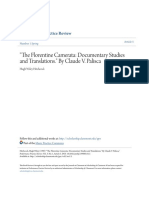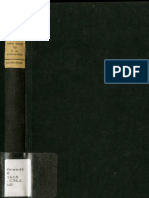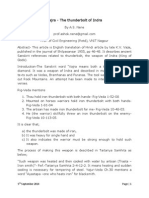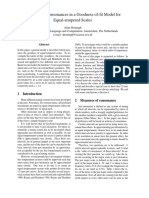The Daesian Scale As Presented in The Musica Enchiriadis Treatise.
The Daesian Scale As Presented in The Musica Enchiriadis Treatise.
Uploaded by
Camilo Ignacio Leal MolinaCopyright:
Available Formats
The Daesian Scale As Presented in The Musica Enchiriadis Treatise.
The Daesian Scale As Presented in The Musica Enchiriadis Treatise.
Uploaded by
Camilo Ignacio Leal MolinaCopyright
Available Formats
Share this document
Did you find this document useful?
Is this content inappropriate?
Copyright:
Available Formats
The Daesian Scale As Presented in The Musica Enchiriadis Treatise.
The Daesian Scale As Presented in The Musica Enchiriadis Treatise.
Uploaded by
Camilo Ignacio Leal MolinaCopyright:
Available Formats
Writing Assignment 1,
Camilo Leal
FEATURES OF THE DAESIAN SCALE AS PRESENTED IN MUSICA ENCHIRIADIS TREATISE.
In the history of medieval western music we can find several theoretical treatises that addressed musical behaviors which reflected specific aesthetic and theoretical thoughts. Some of those behaviors tended to disappear or evolve into new rules that might have transformed, redefined or even rejected those old ones that those treatises were attempting to preserve. Nevertheless, it is important to understand that the influence that those ideas had on the specific values of a period, were crucial to the evolution of western music as we know it today. The Daesian symbols were referred to in just a few theoretical treatises dated between the late IXth and the second half of the XIth centuries,1 one of those being the Musica Enchiriadis treatise.2 (A treatise concerned with theoretical and practical issues related to chant and particularly with those of two voices polyphony, referred in the book as organum and/or diaphony).3 They [Daesian Symbols] are a series of symbols that organize the Daesian scale, 18 tones in four groups of four plus two added notes.4 The name Daesian refers to the type of symbols utilized and their shape of a daseia5, which is a Greek character.6 The four groups of tones called above are, from bottom to top, Graves, Finales, Superiores and Excellentes, plus 2 more tones above.7 The names of the tones in every group were the same: protus, deuterus, tritus and tetrardus.8 A common organizational feature of all
1
Raymond Erickson, The Daesian scale and notation, "Musica enchiriadis, Scolica enchiriadis " in Grove Music Online. Oxford Music Online, http://www.oxfordmusiconline.com/subscriber/article/grove/music/19405 (accessed September 8, 2012). 2 Ibid. 3 Raymond Erickson, Introducction to Musica enchiriadis and Scolica enchiriadis. Trans. Raymond Erickson. ed. C.V. Palisca (New Haven, CT, 1995), xxii, xxxiii. 4 Raymond Erickson, The Daesian scale and notation in "Musica enchiriadis, Scolica enchiriadis.". 5 Raymond Erickson, Introducction, xxxi. 6 Raymond Erickson, The Daesian scale and notation in "Musica enchiriadis, Scolica enchiriadis.". 7 Musica enchiriadis and Scolica enchiriadis, 3. 8 Ibid., 2.
Writing Assignment 1,
Camilo Leal
FEATURES OF THE DAESIAN SCALE AS PRESENTED IN MUSICA ENCHIRIADIS TREATISE. groups is the interval of a whole tone between the protus and the deuterus, a half step between the deuterus and the tritus, and a whole tone between the tritus and the tetrardus.9 Ex. 1
10
We observe that the scale is formed by the superposition of tetrachords related one to each other within the placement of the interval of a half step between the second and the third tone, the deuterus and the tritus.11 As can be seen in example 1, specifically looking at the relationship between the tones bb, b, f, f#, c and c#, the Daesian scale is not based on the relation of a perfect octave and its division in tones and semitones,12 and it might appear that the scale is not consistent with the practice of doubling the melody at the [interval of an] octave.13 Nevertheless, we should consider the possibility that the Dasian system was developed in order to describe and project the systematic harmonization of the original melody within an interval of a perfect fourth or a perfect fifth instead of an octave, mainly because the harmonization at the interval of the octave was
9
Ibid.
10 11 12
13
Taken from the Article The Diatonic "Chromaticism" of the "Enchiriadis"; Lincoln Bounce Spiess. Journal of the American Musicological Society, Vol. 12, No. 1 (Spring, 1959), pp. 1-6.University of California. Press on behalf of the American Musicological Society Stable, 2. Musica enchiriadis and Scolica enchiriadis, 6. Raymond Erisckson, Introduction, xxxi. Lincoln Bunce Spiess, The Diatonic "Chromaticism" of the "Enchiriadis", 2.
Writing Assignment 1,
Camilo Leal
FEATURES OF THE DAESIAN SCALE AS PRESENTED IN MUSICA ENCHIRIADIS TREATISE. considered as something that occurs naturally.14 Thus, it did not necessarily have to follow the structure of the Daesian scale in relation to its position (of that voice in relation of the group in which it moves).15 Also, there are some chromatic alterations referred to in the Enchiriadis treatises,16 which apply, apparently, only to the organal voice17 (that which is harmonizing a given melody at the interval of a fourth or fifth), to avoid the harmonic interval of an augmented 4th or diminished 5th. We can conclude that the Daesian system, as presented in the Musica Enchiriadis treatise is a conceptualization which attempts, quite successfully, to theorize practices that were already in usage18, is functional to the performance (improvisation) of the organum at the interval of a fifth below the principal voice19, it doesnt solve by itself the issues related to the performance of the organum at the interval of a fourth or an octave and, thus, it depends on the teaching of techniques and devices to avoid those issues.20 But maybe the most relevant conclusion is the fact that the conceptualization of those polyphonic practices shows us an intellectual and highly developed musical environment,21 concerned with the task of education as an important way to preserve its values. Moreover, the word Daesian appears not to be familiar to the contemporary music student or even music teacher, considering the affirmation of Lincoln Bunce Spiess (on his article The Diatonic "Chromaticism" of the "Enchiriadis" Treatises) THE SIGNIFICANCE of the
14
Raymond Erisckson, Introduction, xxxiii. Lincoln Bunce Spiess, The Diatonic "Chromaticism" of the "Enchiriadis" , 2. Ibid., 4, 5. Ibid., 3, 4.
15 16 17
18
Claude V. Palisca, preface to Musica Enchiriadis and Scholica Enchiriadis; Trans. Raymond Erickson. ed. C.V. Palisca (New Haven, CT, 1995), xii. 19 Raymond Erickson, Introduction, xxxiii. 20 Ibid. 21 Claude V. Palisca, preface, xi.
Writing Assignment 1,
Camilo Leal
FEATURES OF THE DAESIAN SCALE AS PRESENTED IN MUSICA ENCHIRIADIS TREATISE. Enchiriadis treatises for our knowledge of the beginnings of polyphony is known to any student in a music history course. The musical illustrations in those treatises are less known, however, except for a few examples 22 ; which take us to the following reflection: How do we know now what is and what is not important to study about music history? Practical issues in the chant practices of the IXth century appear not to be so important today except for the performers of that repertoire, but could the study of these ancient thoughts be important for the understanding of why music sounds like it does? We tend to believe that it is. Especially since aesthetic values change over time and, thus, old practices could always become new referents.
22
Lincoln Bunce Spiess, The Diatonic "Chromaticism" of the "Enchiriadis", 1.
Writing Assignment 1,
Camilo Leal
FEATURES OF THE DAESIAN SCALE AS PRESENTED IN MUSICA ENCHIRIADIS TREATISE.
Bibliography Anonimous. Musica enchiriadis and Scolica enchiriadis, trans. R. Erickson. ed. C.V. Palisca (New Haven, CT, 1995). Erickson, Raymond. "Musica enchiriadis, Scolica enchiriadis". In Grove Music Online. Oxford Music Online, http://www.oxfordmusiconline.com/subscriber/article/grove/music/19405 (accessed September 8, 2012). Spiess, Lincoln Bounce. The Diatonic "Chromaticism" of the "Enchiriadis". Journal of the American Musicological Society, Vol. 12, No. 1 (Spring, 1959), pp. 1-6.University of California. Press on behalf of the American Musicological Society Stable.
You might also like
- Beowulf An Illustrated Edition Free Ebooks PDFDocument3 pagesBeowulf An Illustrated Edition Free Ebooks PDFasifali0% (1)
- Dualism and PolarismDocument22 pagesDualism and PolarismNataša StepanovićNo ratings yet
- The Florentine Camerata: Documentary Studies and Translations.Document5 pagesThe Florentine Camerata: Documentary Studies and Translations.Gabriel LopezNo ratings yet
- VondelDocument667 pagesVondelFaiz AizNo ratings yet
- The Fibonacci Sequence and The Golden Ratio: A Brief Historical TimelineDocument2 pagesThe Fibonacci Sequence and The Golden Ratio: A Brief Historical Timelinesheetal0% (1)
- That Crown of ThornsDocument7 pagesThat Crown of ThornsscribdscribdjlpNo ratings yet
- Ernst Cassirer Et Al. - Some Remarks On The Question of The Originality of The Renaissance (Journal of The History of Ideas, 4, 1, 1943)Document27 pagesErnst Cassirer Et Al. - Some Remarks On The Question of The Originality of The Renaissance (Journal of The History of Ideas, 4, 1, 1943)carlos murciaNo ratings yet
- Guitar Scales Infinity - Andy SchneiderDocument132 pagesGuitar Scales Infinity - Andy SchneiderRaul F Thirth100% (24)
- Differences, Vol 6, No 2-3 (2011) - The Sense of SoundDocument329 pagesDifferences, Vol 6, No 2-3 (2011) - The Sense of SoundvictorNo ratings yet
- Solo Percussion Music of Franco DonatoniDocument6 pagesSolo Percussion Music of Franco DonatoniGrantNo ratings yet
- Both from the Ears and Mind: Thinking about Music in Early Modern EnglandFrom EverandBoth from the Ears and Mind: Thinking about Music in Early Modern EnglandNo ratings yet
- TheDocument46 pagesThefrederic9866No ratings yet
- 2013 (C) - Mesopotamian Mathematics From The Inside and From The Outside - SDocument29 pages2013 (C) - Mesopotamian Mathematics From The Inside and From The Outside - S57larh57No ratings yet
- A Survey of Publications On Sumero-Akkadian Mathematics, Metrology and Related MattersDocument172 pagesA Survey of Publications On Sumero-Akkadian Mathematics, Metrology and Related MattersKepa Martinez GarciaNo ratings yet
- HOULE The Origins of The Measure in The 17th CenturyDocument18 pagesHOULE The Origins of The Measure in The 17th CenturyDomen MarincicNo ratings yet
- A Remarkable Collection of Babylonian Mathematical TextsDocument11 pagesA Remarkable Collection of Babylonian Mathematical Textsdavid.contatos4308No ratings yet
- The Roman Conquest of Wales AD 47-410Document64 pagesThe Roman Conquest of Wales AD 47-410Gamer4242No ratings yet
- Leon Crickmore: Planets Heptachords and The Days of The WeekDocument9 pagesLeon Crickmore: Planets Heptachords and The Days of The WeekGuillaume Denom100% (1)
- Dumbrill Ed, Proceedings of Intern Conference of Near Eastern Archaeomusicology, 2008 PDFDocument222 pagesDumbrill Ed, Proceedings of Intern Conference of Near Eastern Archaeomusicology, 2008 PDFFotis AnagnostopoulosNo ratings yet
- Patronage System in The Baroque and Classical Periods 2Document8 pagesPatronage System in The Baroque and Classical Periods 2api-362008658No ratings yet
- Gabriella F. Scelta - The History and Evolution of The Musical SymbolDocument11 pagesGabriella F. Scelta - The History and Evolution of The Musical Symbolajnnc100% (1)
- Studies On The Samaveda - Faddegon, B PDFDocument84 pagesStudies On The Samaveda - Faddegon, B PDFLangravio Faustomaria Panattoni100% (1)
- Selections From Scottish Canadian PoetsDocument340 pagesSelections From Scottish Canadian Poetsjimmy_wood100% (1)
- Barker 2010 Musical Aesthetics in Ptolemy's Harmonics. ArtDocument19 pagesBarker 2010 Musical Aesthetics in Ptolemy's Harmonics. ArtSantiago Javier BUZZINo ratings yet
- Lyra GraecaDocument490 pagesLyra GraecaClaudia A. G. Da SilvaNo ratings yet
- Baudez - The Maya Snake Dance - Ritual and CosmologyDocument17 pagesBaudez - The Maya Snake Dance - Ritual and CosmologyRex MexNo ratings yet
- Hu Zhuqing - On The Theory and Practice of Chromaticism in Renaissance MusicDocument539 pagesHu Zhuqing - On The Theory and Practice of Chromaticism in Renaissance Musiclubas2100% (1)
- Decipherment of The Earliest Tablets Denise Schmandt-BesseratDocument4 pagesDecipherment of The Earliest Tablets Denise Schmandt-Besseratmark_schwartz_41No ratings yet
- The Key To Human KindDocument797 pagesThe Key To Human KindRonald CarletonNo ratings yet
- Thorton, Elements of The Written Language, Philosophical Division of SpeechDocument122 pagesThorton, Elements of The Written Language, Philosophical Division of SpeechnatzucowNo ratings yet
- Luther Music Theory Final Draft 231011 OnlineDocument26 pagesLuther Music Theory Final Draft 231011 Onlinetito154aNo ratings yet
- Conybeare - Illustrations of Anglo Saxon PoetryDocument403 pagesConybeare - Illustrations of Anglo Saxon PoetryAnonymous TNaPN570No ratings yet
- Expressing The Inexpressible - A Plan of Concentration by Zebulon U. GoertzelDocument48 pagesExpressing The Inexpressible - A Plan of Concentration by Zebulon U. GoertzelZebulon Tariq Ulysses GoertzelNo ratings yet
- Babylonian Sqrt2Document13 pagesBabylonian Sqrt2Guillermo AlzagaNo ratings yet
- Pliny The Elder and Ancient PrecedentsDocument1 pagePliny The Elder and Ancient PrecedentsPradeep ChauhanNo ratings yet
- Everist Metz FragmentDocument30 pagesEverist Metz FragmentXavier Chabou100% (1)
- When The Theorists Are Silent Mattheson, Bach and The Development of Historically Informed Analytical TechniquesDocument18 pagesWhen The Theorists Are Silent Mattheson, Bach and The Development of Historically Informed Analytical TechniquesMeriç KırgınNo ratings yet
- GODWIN, JOSCELYN. Instruments in Robert Fludd's Utriusque CosmiDocument16 pagesGODWIN, JOSCELYN. Instruments in Robert Fludd's Utriusque CosmiMaria GCNo ratings yet
- Kokin Wakashu: With Tosa Nikki and Shinsen WakaDocument403 pagesKokin Wakashu: With Tosa Nikki and Shinsen WakaQuynh DoanNo ratings yet
- 3,000 Years of Equal TemperingDocument3 pages3,000 Years of Equal TemperingAndrewNo ratings yet
- The Invention of Prose 1st Edition Simon Goldhill 2024 Scribd DownloadDocument81 pagesThe Invention of Prose 1st Edition Simon Goldhill 2024 Scribd Downloadserenicashes96100% (4)
- Cornford UnwrittenPhilosophyDocument46 pagesCornford UnwrittenPhilosophyAtienza P EdisonNo ratings yet
- Faery QueenDocument600 pagesFaery QueenC gNo ratings yet
- Aristophanes v3Document496 pagesAristophanes v3Nelly DaratrazanoffNo ratings yet
- Florentine Interest in Ptolemaic Cartography As Background For Renaissance PaintingDocument20 pagesFlorentine Interest in Ptolemaic Cartography As Background For Renaissance PaintingZhennya SlootskinNo ratings yet
- Boethius On The Mechanics of Sound (De Musica, 1, 3)Document1 pageBoethius On The Mechanics of Sound (De Musica, 1, 3)Erik Norvelle100% (1)
- Uruk Magnetic Archaeology 22878-62301-1-PBDocument5 pagesUruk Magnetic Archaeology 22878-62301-1-PBeanna8No ratings yet
- Vajra The Thunderbolt of IndraDocument2 pagesVajra The Thunderbolt of IndrasashoksadashivneneNo ratings yet
- Hilborne T. Cresson - On Aztec Music (1883)Document12 pagesHilborne T. Cresson - On Aztec Music (1883)Humberto Sanchez100% (1)
- Penicka - Men of Faith - Stravinsky MaritainDocument41 pagesPenicka - Men of Faith - Stravinsky MaritainMatteo MacinantiNo ratings yet
- Consonant Deletion, Obligatory Synharmony, Typical Suffixing: An Explanation of Spelling Practices in Mayan Writing. Written Language & Literacy 13:1 (2010), 118-179.Document0 pagesConsonant Deletion, Obligatory Synharmony, Typical Suffixing: An Explanation of Spelling Practices in Mayan Writing. Written Language & Literacy 13:1 (2010), 118-179.dmoramarinNo ratings yet
- Music of MynmarDocument35 pagesMusic of MynmarSepida MolzNo ratings yet
- Music, Ritual and Cosmology of The Desana and Baniwa People of The Upper Rio Negro, Amazon, BrazilDocument21 pagesMusic, Ritual and Cosmology of The Desana and Baniwa People of The Upper Rio Negro, Amazon, Brazilis taken readyNo ratings yet
- 0402 Raphael's LetterDocument5 pages0402 Raphael's Lettercccc gggg oooNo ratings yet
- The Veiled Echo - A History of The Fugue. by Petros Vouris (2015) Baroque Music History.Document10 pagesThe Veiled Echo - A History of The Fugue. by Petros Vouris (2015) Baroque Music History.Petro Vouris100% (1)
- Catholic Music in The Diocese of Augsburg C. 1600: A Reconstructed Tricinium Anthology and Its Confessional ImplicationsDocument58 pagesCatholic Music in The Diocese of Augsburg C. 1600: A Reconstructed Tricinium Anthology and Its Confessional ImplicationspaulgfellerNo ratings yet
- Rice 2010 Ethnomusicological TheoryDocument36 pagesRice 2010 Ethnomusicological Theoryjavier_silva_zurita100% (1)
- On The Source of D'aguilon's Arc Color Mixture Diagram: Rolf G. KuehniDocument9 pagesOn The Source of D'aguilon's Arc Color Mixture Diagram: Rolf G. KuehniIoan ManoleNo ratings yet
- Buckland, T J - Dance, Authenticity and Cultural Memory. The Politics of EmbodimentDocument19 pagesBuckland, T J - Dance, Authenticity and Cultural Memory. The Politics of EmbodimentRomario PatogianNo ratings yet
- Shakespeare and Music With Illustrations from the Music of the 16th and 17th centuriesFrom EverandShakespeare and Music With Illustrations from the Music of the 16th and 17th centuriesNo ratings yet
- ABRSM Grade 8 Music Theory-1Document71 pagesABRSM Grade 8 Music Theory-1Nuwemuramuzi Ian MartinNo ratings yet
- Minor Scale Lesson PlanDocument7 pagesMinor Scale Lesson PlanThiago André100% (1)
- A Theory of Pure Design - Harmony, Balance, Rhythm (1907)Document228 pagesA Theory of Pure Design - Harmony, Balance, Rhythm (1907)Vlad CoceaNo ratings yet
- Cube Dance PaperDocument19 pagesCube Dance PaperLuis Nuño100% (1)
- Practical Counterpoint PDFDocument80 pagesPractical Counterpoint PDFDeon D'Souza100% (2)
- Nota HarmoniDocument11 pagesNota HarmoniElyn LuNo ratings yet
- Linear Bass Patterns Take Another Look at - Dr. William FowlerDocument88 pagesLinear Bass Patterns Take Another Look at - Dr. William FowlermaxiqlokuraNo ratings yet
- Keyboard Syllabus 2011 - Updated 030910-1Document84 pagesKeyboard Syllabus 2011 - Updated 030910-1Olsi Qinami100% (1)
- HONINGH, Aline - Measures of Consonances in Goodness-Of-fit Model For Equal-Tempered ScalesDocument4 pagesHONINGH, Aline - Measures of Consonances in Goodness-Of-fit Model For Equal-Tempered ScalesRaphael Mizrahi100% (1)
- 2019 OPC Piano PlaybookDocument27 pages2019 OPC Piano PlaybookHenry Sloan100% (5)
- Anna MorcomDocument23 pagesAnna MorcompratNo ratings yet
- Modulations in Microtonal SpaceDocument21 pagesModulations in Microtonal SpaceBil Smith100% (1)
- 978-3-030-15046-4 - 3 Extended Techiques SaxDocument7 pages978-3-030-15046-4 - 3 Extended Techiques SaxROMCNo ratings yet
- The Electric Bass-University of Southern California PDFDocument10 pagesThe Electric Bass-University of Southern California PDFcostelo63No ratings yet
- Theory and Analysis: Correlated For Use With AP® Music TheoryDocument20 pagesTheory and Analysis: Correlated For Use With AP® Music TheoryJMNo ratings yet
- Diatonic and Chromatic PDFDocument17 pagesDiatonic and Chromatic PDFRidalyn AdrenalynNo ratings yet
- Presentation 2 The Devil'S IntervalDocument5 pagesPresentation 2 The Devil'S IntervalallysterNo ratings yet
- Using Intervallic Studies From Bach's Toccata and Fugue For Technique and Flexibility Best. Saxophone. Website. Ever.Document7 pagesUsing Intervallic Studies From Bach's Toccata and Fugue For Technique and Flexibility Best. Saxophone. Website. Ever.Col BoyceNo ratings yet
- Mapeh PT With Tos q2Document12 pagesMapeh PT With Tos q2Chona RenosaNo ratings yet
- Jeopardy - Music TheoryDocument27 pagesJeopardy - Music Theoryapi-294225795No ratings yet
- IntervalsDocument1 pageIntervalssongeekuNo ratings yet
- Ted Greene Chord Studies PDFDocument861 pagesTed Greene Chord Studies PDFBob BaoBab100% (6)
- Turkish Makam Music Composition by Using Deep Learning TechniquesDocument94 pagesTurkish Makam Music Composition by Using Deep Learning TechniquesTaner ÖNGÜNNo ratings yet
- Sevish - Rhythm and Xen - Rhythm and Xen - Notes PDFDocument9 pagesSevish - Rhythm and Xen - Rhythm and Xen - Notes PDFCat ‡100% (1)
- 101 Ear Training Tips For The Modern MusicianDocument120 pages101 Ear Training Tips For The Modern MusicianKlaus FischerNo ratings yet
- IB 11 SS Part 1 - MelodyDocument12 pagesIB 11 SS Part 1 - MelodyjjNo ratings yet
- The Rags of North in D Ia N Music: Their Structure and EvolutionDocument218 pagesThe Rags of North in D Ia N Music: Their Structure and EvolutionLuchmee Goorjhun100% (1)

























































































